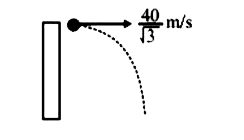An object 0.5kg is dropped from a height 10m at what height will the velocity be equal to 10 ms−1(gravitational acceleration g=10ms2)
To solve the problem, we will use the principle of conservation of mechanical energy. The total mechanical energy (potential energy + kinetic energy) of the object remains constant if we ignore air resistance.
1. Identify the initial conditions:
- Mass of the object, m=0.5kg
- Initial height, h0=10m
- Final velocity, v=10m/s
- Gravitational acceleration, g=10m/s2
2. Calculate the initial potential energy (PE_initial):
PEinitial=mgh0=0.5×10×10=50J
3. Calculate the kinetic energy (KE_final) when the velocity is 10 m/s:
KEfinal=12mv2=12×0.5×(10)2=12×0.5×100=25J
4. Apply the conservation of energy principle:
The total mechanical energy at the initial height will be equal to the total mechanical energy at the height where the velocity is 10 m/s.
PEinitial=PEfinal+KEfinal
5. Express the final potential energy (PE_final):
Let h be the height at which the velocity is 10 m/s. Thus,
PEfinal=mgh=0.5×10×h=5hJ
6. Set up the equation:
50=5h+25
7. Solve for h:
50−25=5h
25=5h
h=255=5m
8. Determine the height above the ground:
Since the object was dropped from 10 m, the height above the ground when the velocity is 10 m/s is:
Height above ground=10−h=10−5=5m
Final Answer:
The height at which the velocity of the object is equal to 10 m/s is 5 meters above the ground.
---
- Mass of the object, m=0.5kg
- Initial height, h0=10m
- Final velocity, v=10m/s
- Gravitational acceleration, g=10m/s2
PEinitial=mgh0=0.5×10×10=50J
KEfinal=12mv2=12×0.5×(10)2=12×0.5×100=25J
The total mechanical energy at the initial height will be equal to the total mechanical energy at the height where the velocity is 10 m/s.
PEinitial=PEfinal+KEfinal
Let h be the height at which the velocity is 10 m/s. Thus,
PEfinal=mgh=0.5×10×h=5hJ
50=5h+25
50−25=5h
25=5h
h=255=5m
Since the object was dropped from 10 m, the height above the ground when the velocity is 10 m/s is:
Height above ground=10−h=10−5=5m
The height at which the velocity of the object is equal to 10 m/s is 5 meters above the ground.
Topper's Solved these Questions
Similar Questions
An object of 100 kg is lifted to a height of 10 m vertically. What will be the work done ?
[g=9.8m/s2]
View SolutionAn object is dropped from rest at a height of 150m and simultanously another object is dropped from rest at a height 100m. What is the difference in their height after 2s if both the objects drop with same acceleration ? How does the difference in height vary with time ?
View Solution
Knowledge Check
A body of mass 20 kg is dropped from a height of 2 m. If g is taken to be equal to 10 m/s2, the kinetic energy of the body, just before striking the ground, will be
A400 JB4 JC40 JDnone of theseA body of mass 2 kg is dropped from rest from a height 20 m from the surface of Earth. The body hiys the ground with velocity 10 m/s, then work done (g=10m/s2)
AOn the body is 100 jBBy the gravity is 400 JCBy the dissipative force is 300 JDBy the disspipative force is −300JA body of mass 10 kg is dropped to the ground from a height of 10 metres. The work done by the gravitational force is (g=9.8m/sec2)
A−490 joulesB+490 joulesC−980 joulesD+980 joules
A ball of mass 0.15kg is dropped from a height 10m strikes the ground and rebounds to the same height. The magnitude of impulse imparted to the ball is (g=10ms2) nearly:
View SolutionA projectile is projected from top of a wall 20m height with a speed of 10m/s horizontally. Find range (g=10ms2)
View SolutionA particle is projected horizontally with a speed of 40√3m/s, from some height t=0. At what time its velocity makes 60∘ angle with initial velocity.
(g=10m/s2)

View SolutionA ball is dropped from a height of 20m and rebounds with a velocity which is 34 of the velocity with which it hits the ground. What is the time interval between the first and second bunces (g=10m/s2)
View SolutionA ball falls on the ground from a height of 10m and rebounds to a height of 8m. What is the percentage loss kinetic energy of the ball? (g=10m/s2)
View Solution
